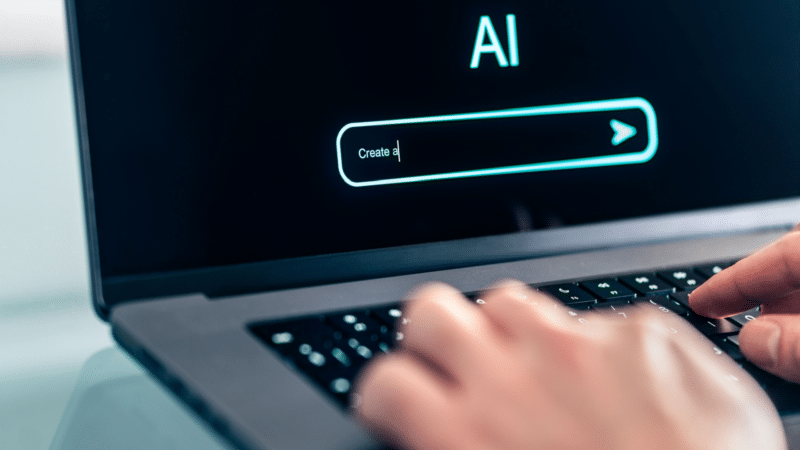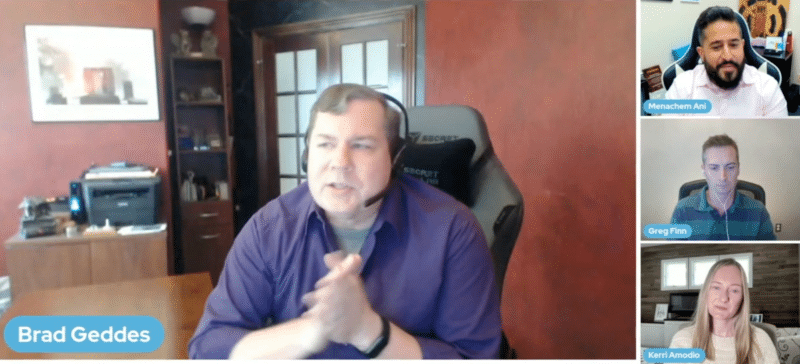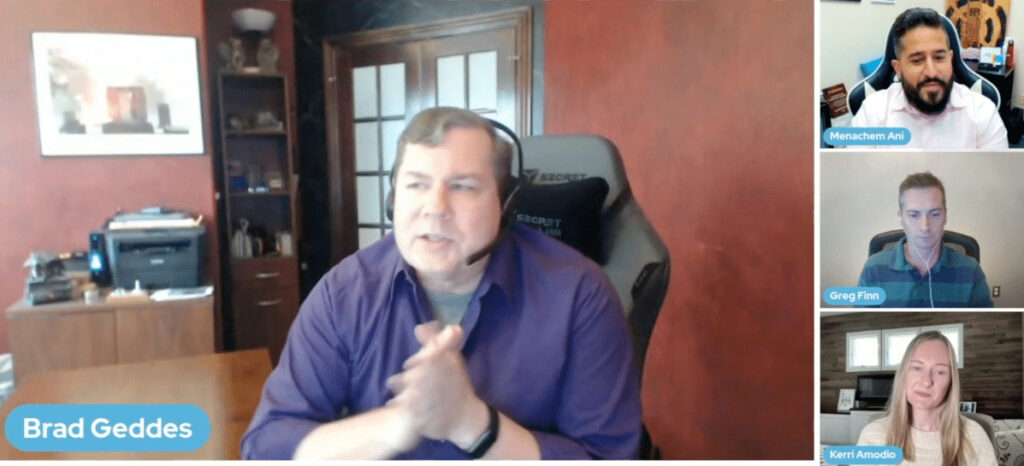
A panel of three PPC marketing experts – Greg Finn (Cypress North), Kerri Amodio (Refine Labs), and Menachem Ani (JXT Group) – tackled a fundamental question at SMX Next: Is AI making marketers better?
The panel discussed artificial intelligence’s evolving role in marketing, offering insights into its promises and pitfalls.

The discussion was nuanced. While AI excels at increasing output quantity, there are serious concerns about quality.
The new PPC mindset
Finn notably argued that AI is potentially making marketing worse when used as a complete solution rather than a strategic tool:
- “Is it being able to produce more items and content, things like that. I would say yes, if quantity is your guiding light, but if it’s quality, I would argue strongly that AI is making marketing in general and marketers worse.
- “People really rely on AI to do things that I think could probably be done better by a human. And a lot of the changes in platforms themselves really lend themselves to just worse.
- “It really comes down to how we’re using it and those people that are using it as a strategy, not a tactic, I think it’s making them worse.”
This sentiment was echoed by his fellow panelists, who emphasized the importance of thoughtful implementation.
Ani said:
- “Like a lot of things, it’s really how you use it. It makes it very easy to get bad output, I think almost too easy.
- “The harder you work at something, the better it’s gonna be. So a lot of it really comes down to how you use it, but it can make marketers better if you’re gonna use it in, in better ways.”
Amodio, agreeing with her fellow experts, expressed that AI can make you a more efficient worker:
- “It can make you a more efficient worker, a more efficient marketer. It can come up with different strategies for you that maybe you wouldn’t have tested on your own.
- “But it also does muddy the waters. It makes us play a game that we are trying to fit our marketing into a box. And that’s not always a good thing.
- “Having to write a certain amount of copy, having to have a certain amount of assets, it can sometimes make us overproduce, quantity over quality and that is where it’s making AI marketers even worse than they were before.”
Where AI shines
The experts identified several areas where AI demonstrates clear value. Automated bidding emerged as a unanimous success story, with Amodio noting she used “smart bidding” in 99% of cases.
Ani shared the success he sees with automated bidding:
- “When we utilize like smart bidding in the ad platform, more algorithmic bidding as opposed to manual bidding.
- “Those are a lot more advanced than utilizing some of the AI tools to build creative assets, to write copy, things of that nature.
- “So in, in my experience, that’s where it shines right now, but I think there’s a lot of others as well.”
Amodio said:
- “I’m going to use smart bidding 99% of the time, to be honest.
- “I have seen it do well in audience targeting scenarios, but there are certain guardrails that you need to put up in order to find the right people.
- “You need to be really diligent about putting a little bit of manual work into that automation and making sure from a backend reporting perspective that you are reaching the right people.
- “But sometimes you can take those guardrails down, let it go find those conversions for you – and I have seen it work well.
- “So for some brands, it’s going to work better than others.”
Finn agreed with his fellow experts on the automated bidding front but also touched on Performance Max campaigns – when properly structured with clear conversion goals, is potentially effective, particularly in ecommerce settings:
- “I’ll just agree on the bidding standpoint, and I do think it’ll be more pronounced
with eCPC going away. It already went away in shopping, at least for Google Ads, and is going away for search ads as well. - “I also think in some supporting assets like using AI in general to come up with more shorts
or vertical video, help edit some of those things down. If we’re taking a clip of this [talk], there are a lot of tools that can go through and do a lot of that work for you. - “Something like a Pmax, with the proper structure, the proper conversion set up the proper game plan in place, it can dominate manual and that’s just a fact.
- “I think it’s really good at broad match. I hated broad match for the majority of my life. I still don’t like saying that I like it now, but broad match DSAs, some of those automation and AI tactics can really go through and get better, coverage for you.”
Common misconceptions about AI in marketing
The panel identified several misconceptions.
A primary concern was the false belief that AI makes things easier.
Finn pointed out that setting up AI-driven campaigns often requires more work, not less, particularly when dealing with complex assets and creative requirements.
- “One of the biggest misconceptions is that it’s a solution that makes things easier just having AI. If you think that’s true, go try to set up a PMax campaign that has images, video, headlines, descriptions etc. It is not easier across the board just because you have AI.
- “That’s different messaging than what the platforms are giving us with Google launching Pmax and Demand Gen at the beginning, those were half-baked products and they’re now finally becoming amazing.
- “Use your eyes. Use your brain. Experiment. Test. See what works.
- “Just because you hear something doesn’t mean it’s true, and it’s really hard to get that through to clients.
- “I dare you to use those assets that Google ads generates – you will be out of a job. Just because you can make things fast doesn’t mean it’s great. … I wanna be the best. I wanna put the best stuff out there, I wanna have the best ads, I one of the best images and I just don’t think with AI alone you can get there.”
The experts also warned against treating AI as a “set it and forget it” solution. Successful implementation often takes weeks or months of refinement, Amodio said, adding:
- “I think one of the biggest challenges, or misconceptions that we have, is people are gonna think that it’s going to work right away and it’s going to work well.
- “I’ve seen this take two weeks, three weeks, a month, for a smart campaign to do better than one that was on a manual bidding strategy. It’s going to take time.
- “Also, it’s not just a set-it-and-forget-it approach. You can’t just assume that AI is in your best interest. You have to really set those guardrails. Look at your search query reports.
- “Look at your audience demographics and put those exclusions in place and make sure that you are reaching the right people because it’s not always just gonna go out and find those right people for you, especially in B2B where we’re dealing with lead generation. It might go get you high volume leads, but it doesn’t mean that they’re quality.”
Creativity and AI: How do you see this interplay between AI and creativity evolving?
One of the most compelling discussions centered on the intersection of AI and creativity. The panelists expressed concern about the potential homogenization of creative content, with Amodio highlighting the risk of needing to play the game but also ensuring you are creating ads that deal with customer pain points:
- “I keep going back to this same point over and over … do we really even want to play the game that the algorithms are laying out? On one hand, you do – you want to provide all the assets that you possibly can…
- “But at the same time, when creative teams are so focused on just pumping out high volume, they’re not focused on quality; they’re not focused on the messaging, they’re not focused on aligning to the ICP and the audience and their pain points.
- “There is that risk of losing that creativity and losing that connection between the brand and the audience.
- “But there is this level of in between that we have to find, we have to have all the assets on all the right sizes for all the right placements. Then we also have to make sure that messaging is on par, which is not saving us time necessarily because we have so many more assets to create.
- “Teams have to be really careful about pre-planning and they have to sit down with their demand teams or paid media teams, creative teams and talk about all the resources that they need to create for a given campaign.
- “Know in advance, these are all the sizes, these are all the specs that we need, and be really diligent and really careful about, especially the budget that we wanna spend, especially if you’re going into a video production creating these very expensive lengthy videos can cost quite a bit of money. how can you turn that one big video shoot into hundreds of assets?”
Which AI solutions in platforms would you never try?
Amodio doesn’t like PMax for B2B:
- “In the B2B world, I stay away from PMax. I don’t think that there’s a whole lot of value there. I’ve never really seen it work. I don’t think that in the B2B world you need to give up control.
- “I don’t believe that paid search should be a brand play. It should really be a demand capture play where we’re driving demos for or signups for your product or you know, to talk to sales. So we’re driving these high intent conversions.”
Ani doesn’t believe in absolutes:
- “I’m a big fan of no absolutes in marketing. I like to test things. There are things that just don’t work in certain places. I think like Performance Max for lead gen is a very difficult one to get right.
- “But for the most part, I try to figure out a way to test it and see if I can because what happens is we end up with preconceived notions and AI can sometimes surprise you.”
Finn doesn’t trust “amazing Google updates”:
- “I don’t trust anything that Google just releases and says is amazing. Down the road, it could be amazing, but they are building as they go with some of the stuff.
- “They’re like, ‘oh the Product Studio has videos.” If you go in there, you have to add some logos, some images, some texts. It is a thrift store … not a good product.”
- “When PMax came out, I came out with PMin stickers … because I hated it so much.
- “Demand Gen stunk when it came out.
- “I wouldn’t say that I don’t ever use it but I’m just dubious when something is launched and touted to be this amazing tool that Google has.”
What’s next for AI in PPC?
Use this moment of AI saturation as an opportunity to invest in high-quality, custom creative work that stands out from algorithmic content.
What about practical recommendations for marketers looking to incorporate AI responsibly? The panel offered these concrete suggestions:
- Start with controlled experiments rather than wholesale changes.
- Use AI tools for specific tasks like video editing and initial ad copy ideation.
- Maintain strict brand guidelines when using AI for content generation.
- Use Amy Hebdon’s guide – ChatGPT for PPC: 17 strategic prompts you can use today.
- Keep automated recommendations and auto-apply settings turned off, particularly on advertising platforms.
- Focus on using AI to enhance, rather than replace, human strategic thinking.
The panel concluded that while AI represents a powerful set of tools for modern marketers, success lies in:
- Thoughtful implementation.
- Maintaining human oversight.
- Using automation to enhance (not replace) strategic thinking.
This era of increasing automation might actually be the perfect time to differentiate through high-quality, human-directed creative work, As Finn summarized.
Watch: Have you switched to the new PPC mindset? + Overtime live Q&A
Here’s the full panel discussion from SMX Next:

